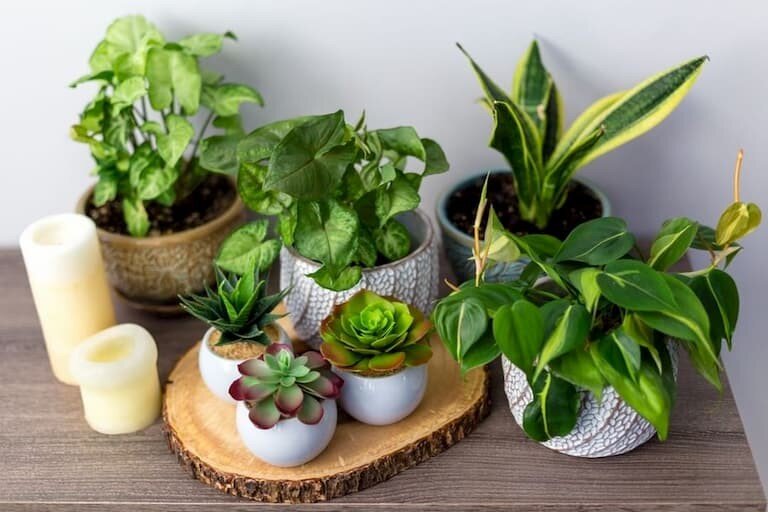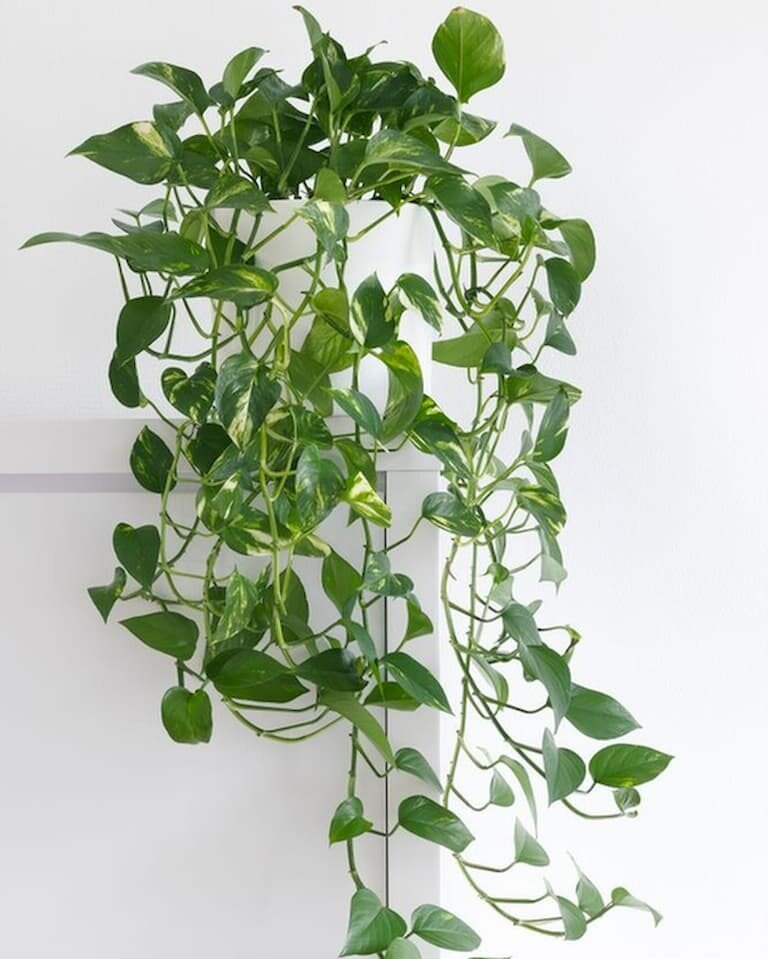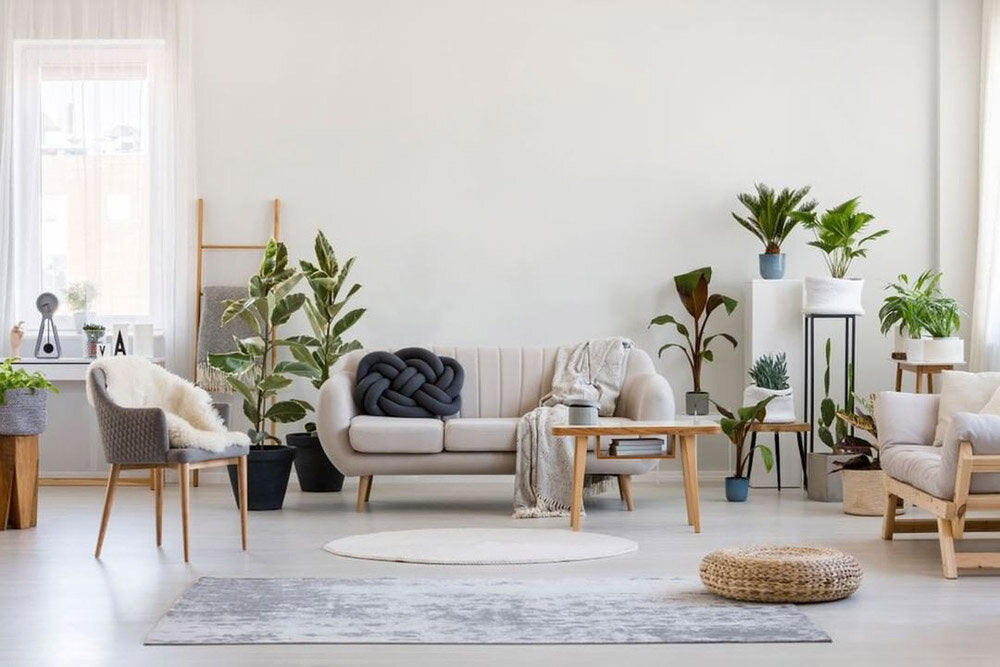YOU WANT TO DESIGN AN URBAN JUNGLE FOR YOUR HOME?
In this complete guide, I reveal some of the latest green design ideas and tips to help you design the most fabulous urban jungle for your home.
-
URBAN JUNGLE DÉCOR IDEAS
-
ESSENTIAL ACCESSORIES AND TOOLS
-
WHICH FACTORS AFFECT THE CHOICE OF YOUR NEW PLANT
-
WHICH PLANTS TO START WITH
-
CARE TIPS
Happy planting!

Hotel room temporarily filled with plants in London (Leman Locke hotel - design by Michael Perry)
1) URBAN JUNGLE & HOME DÉCOR IDEAS
VARIETY IS KEY
The essential concept behind any urban jungle is to mimic nature in its extraordinary diversity of species, sizes, forms and colors.
When designing a personal urban jungle at home, variety is key, like in nature.
The combination of different sizes of plants is the first step to creating your indoor jungle. For instance, purchase a giant one that goes on the floor and mix it up with some smaller ones.
Try some plant stands and rope hangers to display your plants at different levels.
If you just go for the same textures, like all small leaves or big leaves or prickly, your garden will look boring.
MAKE IT PERSONAL

Often play around with your pots. Prepare some terracotta, copper, etc. then, mix them up. Add candles and personal object close to your heart.
If you have some old plant pots or teacups, they will be good materials to customize them with paint. Or, you can find some online or other vintage shops.
A MULTI-SENSORY EXPERIENCE
Think about your last walk in the forest or in the jungle. Beyond the sight of trees, plants and bushes, what sounds could you hear, what scents could you smell?
Recreate such memories in your home by adding a plant ASMR or nature sound playlist, or by placing fragrant specimens such as lavender, jasmine or lemongrass. Pot-pourri would do as well.
Trying to please all the senses, that’s the essence of successful biophilic design and urban jungle design!
GREEN LIBRARY – BEST FOR HOME OFFICE

Taking advantage of a surplus library unit at your home and fill it with various kinds of urban jungle plants is a good idea to start with.
Cacti and succulent plants are our first recommendation. They’re cute and small enough to be placed anywhere – in the surplus library unit that you’ve prepared or on the desk.
Some other plants with similar benefits are Sansevieras Trifasciata, snake plants, Philodendron Cordatum, and Epipremnum Aureum.
BATHROOM PLANT WALL
It’s no problem if your bathroom is large or narrow, traditional or ultra-modern, a houseplant or two always create an impressive highlight.
Locations like a corner rack and tabletop bathroom sink are ideal. You can also stick suction pots on the walls. It really works and the result is impressive!

Biophilic hotel bathroom in East London (Leman Locke hotel - design by Michael Perry)
The bathroom is the most humid space in your house, implying an ideal tropical condition that certain plants will love.
Aside from ferns and gorgeous Calathea as suggested above, you can mix it up with some other urban jungle plants, like:
-
Chinese evergreen
-
Peace lily
-
Philodendrons
-
Bamboo
PLAY AROUND THE WINDOWSILLS – BEST FOR KITCHEN

Especially if your kitchen is a kitchenette.
Some little plants like aloes or cacti and succulent plants are perfect for this game. You can plant them in different sizes of pots and display along your kitchen windowsills.
Besides, you can make use of some excess space on your trolleys, open shelves, top of your fridge, extra worktop or dishwasher.
ADD ONE BIG STATEMENT OR TWO – BEST FOR LIVING ROOM
Don’t be afraid to try one giant, big-leafed plant. You’ll be amazed by how jungle-ish (but not cluttered) this big statement transforms your living space.
But if you’re considering getting an expensive large plant, do your homework before to save you some money. This blog is here to cover your back and answer your indoor plant care questions.
Some recommended large plants:
-
Alocasia
-
Banana tree
-
Pancake plant
-
Ficus Lyrata
-
Swiss cheese plant
-
Bird of Paradise
2) URBAN JUNGLE GARDENING: ESSENTIAL TOOLS AND ACCESSORIES
To start and maintain an urban jungle, here are essential indoor gardening tools and accessories that you will need at some point.
WHAT YOU WILL NEED:
-
Get both types of potting soil.
There are two types of houseplant soils: a well-drained soil rich in sand (for cacti, succulents and the associated dry-type of houseplants), and a moister soil for most other common houseplants, especially the tropical ones.
When you add soil to top-up or repot your plant, check about their preferred type of soil. Also, organic soil is the best for plants and also advised by many experts.
-
Fertilizer (a.k.a. plant food)
-
Trays and saucers (for drainage and in order to easily water from below)
-
Watering can
-
Pots
-
Self-watering pots.
For the extra peace of mind, if you have too many plants, or to back you up when you’re away from home, try self-watering plant pots. They are my key partners for the maintenance of the thirsty-type of indoor plants.
EXTRAS (ALSO GOOD GIFT IDEAS)
-
Gardening gloves
-
Gravels of different colors for decorative topping
-
Mini-spade and rake because they’re cute and it makes you look like a pro
-
Mister spray
PLANT PROPAGATION ACCESSORIES:
Did you know you can propagate a plant cutting into many babies?! I’ve easily done this with my golden pothos (and also with an avocado seed). Many houseplants are propagation-friendly.
For the budget-minded gardeners or if you are thinking of propagating your plants for the fun to watch them grow, you'll need propagation plates, propagation tubes or even just a glass or a vase.
3) WHICH FACTORS AFFECT THE CHOICE OF NEW PLANTS?
These factors have an influence on the choice of your new plants:
-
The levels of humidity and light exposure in your house
-
Do you have pets or children?
-
The amount of time you’re at home
For example, if the humidity levels in your house are high, plants like ferns and oh-so-gorgeous Calatheas are amazing to grow, as they require high humidity to thrive.
But most homes are on the dry side, so hardier species such as large monstera deliciosa, succulents, and cacti for example would be more suitable for beginners. These three require minimal maintenance, and would satisfy plant lovers who are not at home regularly.
If you have furry friends or children, stay away from Pothos, Philodendron, and other lush plants as they are toxic to pets. You can check the list of poisonous plants here.
4) WHICH PLANTS TO START WITH?
There are different types of indoor plants and they will have different effects on your interior.
Start with the hardy species.
This will not only save you time and money, but also help you gain more experience and boost your confidence.
After several years helping indoor plant owners with their plant dramas, I’m realising that many need to be reminded that plants are not native from our human-made homes, and some do better than other when it comes to adapting to their new environment.
At the same time, it feels good to know that every indoor gardener kills plants from time to time.
Experimentation is part of any learning process, so, no guilt my plant friends!
Once you’re more familiar with your plants’ needs, you can venture into more exotic and rarer specimens.
SUCCULENTS AND CACTI
Cacti and succulents are for sure the easiest indoor plants for beginners to care for. Succulents and cacti grow well on neglect and like dry soil. Don’t water them as much as the other plants.
Succulents and cacti are going to be placed closer to the windows where they can capture a lot of sunlight. During the winter, you just need to keep them cool and dry.
CRAWLING AND WALL-CLIMBING PLANTS

Crawling and climbing plants immediately create a dramatic effect. If you place a garden trellis against the wall and let a climbing plant grow on it (like instagrammers @mamabotanica or @houseplantjournal), you’re my idol. For beginner indoor gardeners, here are some easy-to-grow vines and climbers to consider:
-
The string of pearls (Senecio rowleyanus): a succulent plant that really loves bright light and dry environments, meaning it’s a low-maintenance creeper. With string of pearls, it’s best to grow them in a hanging basket.
-
Creeping fig (ficus pumila): it’s praised by lots of gardeners due to the small, leathery dark green foliage which is enchanting and easily complements with other houseplants. Creeping fig is also known for vigorous growth and loves a dry environment so, don’t overwater it.
-
Pothos (epipremnum aureum): most of the pothos varieties can grow indoors or under direct sunlight so, it’s not a headache to find a place for it around your house.
-
Ivy: like Pothos, this plant can adapt to a wide range of light conditions and grow super-fast. It needs a wide and shallow container and prefers a spot where there is direct sunlight. If you love evergreen foliage, try this.
-
Heartleaf Philodendron: this is one of the most popular plant to create an urban jungle indoors because of not only their jungle-ish look but also the low maintenance. In dried soil and moderate light condition, they will grow easily.
TERRARIUMS, KOKEDAMA, AND AIR PLANTS

For some extra effects, you can try a few unusual plants, such as air plants, or make your own terrariums. These kinds of plant eco-systems require minimal care and don’t ask for special maintenance skills.
Terrariums are usually grown inside small to medium sized glass containers and air plants are usually seen inside glass globes. Unlike what the name seems to promise, you do need to bring water to air-plants.
On the other hand, kokedama can be nice and fun thing to try. Koke-dama is the name of stylish japanese mossballs.
5) URBAN JUNGLE CARE TIPS
KNOW WHERE YOUR PLANT COMES FROM
Knowing about your new plant’s backstory is going to help you care for them the right way. For example, never put a fern pot near windows because their favorite environment is a humid and shadow one. It’s totally opposite to succulent plants which prefer to live in dry locations. They grow easily in desert areas.
WATERING
The most unforgiving mistake of a beginner indoor gardener is overwatering, because the plant usually reacts to this by sacrificing older leaves at the bottom of the main stem.
In practice, under watering is better than overwatering because plants don’t die in a week, but they will be immediately affected if being watered overly.
So, be sure to test the soil with your finger before deciding to give it some water or not.
LEARN ABOUT PLANT CARE AS EARLY AS POSSIBLE
Home gardening has become a trendy thing to do in urban areas for a good reason. From keeping a connection to nature to impressing our friends with stylish specimens, we like to recreate a jungly atmosphere indoors.
But, if you want to keep your precious plants for a long time, it’s good to learn about plant stuff as early as possible.
So, if you are considering bringing a portion of jungle into your home for the first time, here are a few essential things to know about, and garden nurseries tend not to highlight the importance of enough.
Not all plants are born equal towards surviving indoors, some species are more resilient, others are more fragile. Think about the three factors below the next time you buy a plant.
----------------------------------------------------------------------------------------------------------
Blog written by Boris Dadvisard at Invincible Happy Houseplants

